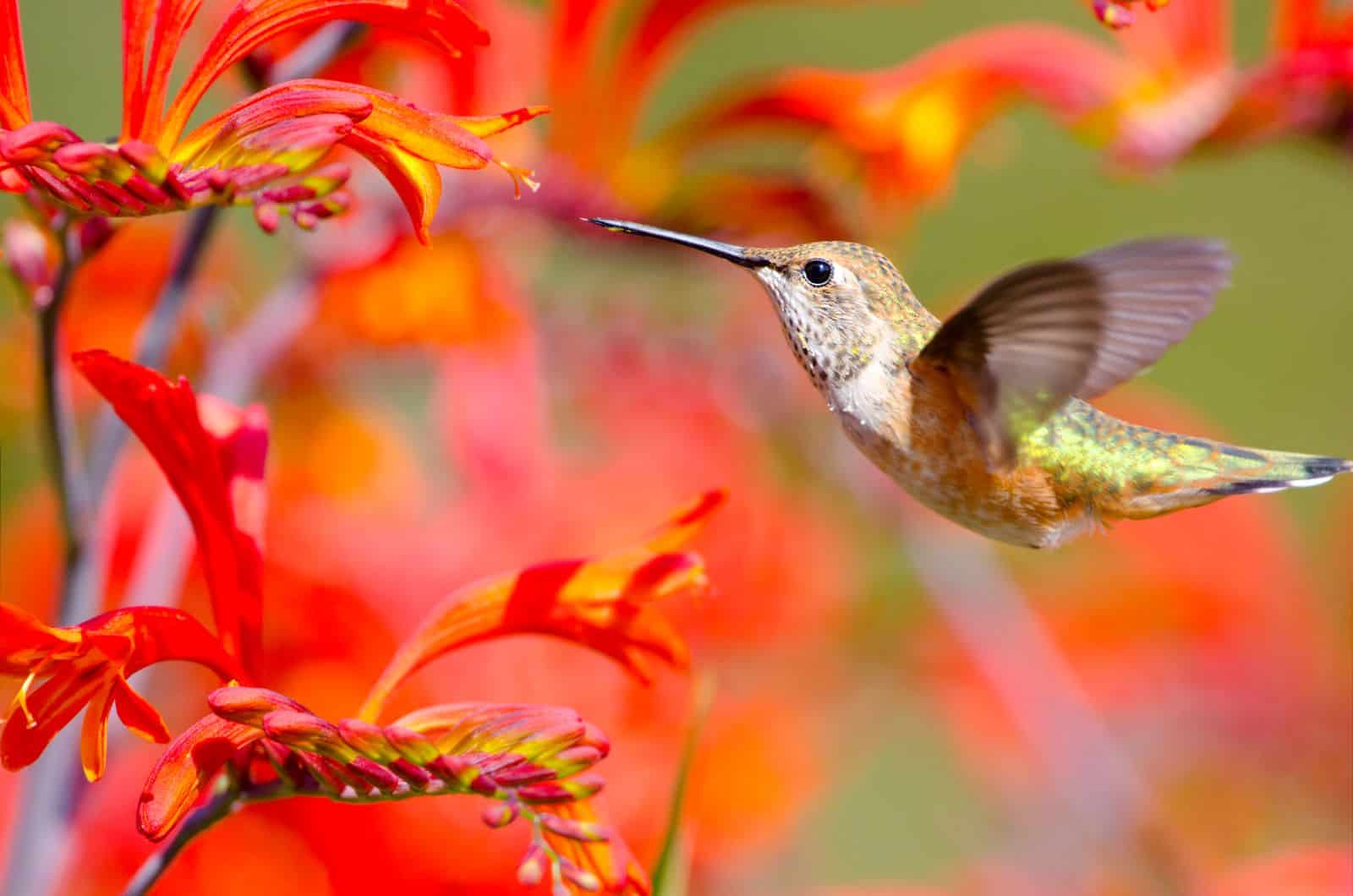
If you want to attract hummingbirds to your yard and garden, you are in good company. It seems like everyone loves hummingbirds.
Hummingbirds are known as the “winged jewels” of the garden. This moniker is appropriate, since the iridescent feathers of hummingbirds reflect gorgeous jeweled tones of brilliant red, vibrant violet, metallic green and blue, and shimmering gold. A hummingbird’s feathers are actually designed to reflect light. That’s why these beautiful birds can look quite dull in the shade, which aids in their ability to hide from predators.

Hummingbirds Live in the Americas
When it comes to attracting hummingbirds, it’s important to know the reality of hummingbird geography. Quite simply, you can’t attract hummingbirds to your yard if you live where there aren’t any hummingbirds.
There are more than 320 species of hummingbirds in the world—and they only live in the Americas. The majority of these extraordinary birds can be found near the equator in South America. Only 16 of hummingbird species migrate to and through the U.S. They are extremely strong fliers and their migration routes can be more than 2,000 miles long.
As you can imagine, these long flights require a lot of energy. Not only do hummingbirds bulk up on their nutrition before their Spring and Fall migrations, they also time their journeys to synch with the bloom times of their favorite flowers along the way. Additionally, hummingbirds have learned the benefits of following migrating Yellow-bellied Sapsuckers. Hummingbirds take advantage of the holes sapsuckers have drilled into trees that are oozing sap, and they feed on the small insects that are attracted to this sap.
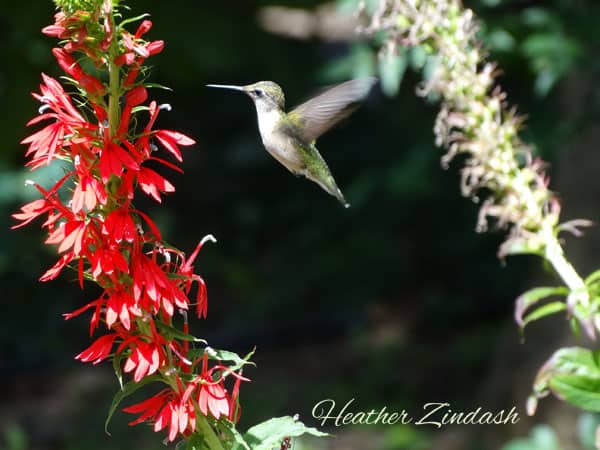
The Ruby-throated hummingbird is the only hummingbird that breeds in the eastern United States, and it has the widest range. Therefore, this species is one of the most commonly seen hummingbirds in yards and gardens. Other common hummingbirds observed in the United States include Anna‘s hummingbird (along the West Coast and mostly in California), Costa’s hummingbird in the desert Southwest and the Rufous hummingbird in its summer breeding grounds of southern Alaska and Canada, as it migrates throughout the Western U.S., and in its winter home in Mexico.
Be sure to check out our Guide to Common American Hummingbirds.
The Physiology of Hummingbirds
These elusive creatures are roughly 3 inches long and weigh a mere 1/10 of an ounce. Yet these tiny birds can create enormous interest and intrigue in your garden.
Hummingbirds can flap their wings at 75 beats per minute. That makes their wings nearly imperceptible. This wing speed allows these birds the unique ability to hover in one place and dart up, down, left, right, even backwards. Just when you think you have caught a glimpse of one of these beauties sipping from their favorite flower—it is gone in a flash!
Hummingbirds have extremely high metabolisms and can consume 12,000 calories per day. That’s why, when you see hummingbirds in your garden, they are probably feeding.
———————————-
Just for Fun:
Click here to see What’s Trending on Amazon.com
———————————–
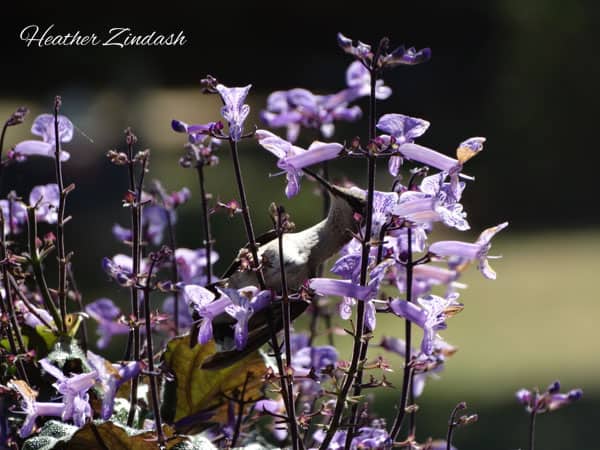
Attract Hummingbirds to Your Yard with Flowering Plants
Most of us are familiar with the hummingbird’s uniquely long beak. But did you know that they use their long tongues to lap nectar from flowers? Therefore, tubular flowers with long corollas are perfectly suited for their needs.
As a result, some plants have evolved to rely specifically on hummingbirds for pollination to ensure their own reproductive success. The hummingbirds are rewarded with delicious nectar, and the plants are rewarded when the hummingbirds inadvertently get pollen on their foreheads and transfer it from one flower to another.
Though hummingbirds are synonymous with sipping flower nectar, they also consume an incredible number of insects, including ants, small flies and wasps, mosquitoes, small beetles, ticks, and spiders. They rely on these insects to feed their young as well.
Check out the flowering perennials at Nature Hills Nursery that attract hummingbirds.
The Ideal Environment to Attract Hummingbirds
The ideal habitat for hummingbirds is a woodland edge with an open area that includes flowering plants. To attract and support hummingbirds in your garden, add plants that bloom in long tubular flowers in red, pink and orange. (Hummingbirds will feed from flowers in other colors, too. But they love “hot” colors.)
Try to provide a succession of these blooms from early Spring to late Fall. Doing so will supply them with a full season of nectar and to help them bulk up for their long migration journeys. Plant several flowering plants together in one or more areas around your garden. That way the birds can collect a large quantity of food while expending little energy to find it. This can be accomplished by designing raised garden islands around your yard.
To enhance your landscape to attract hummingbirds, begin by surveying your garden and the surrounding areas, looking for five important vegetative layers. Look for trees, shrubs, vines, perennials/annuals, and ground cover. These five layers allow for a diverse landscape. Diverse landscapes support a diverse insect population and a well-functioning food web, which includes naturally occurring insect predators, including hummingbirds. When we have an abundance of natural predators and a balanced ecosystem, there is less need for chemical control of insect pests in the garden.
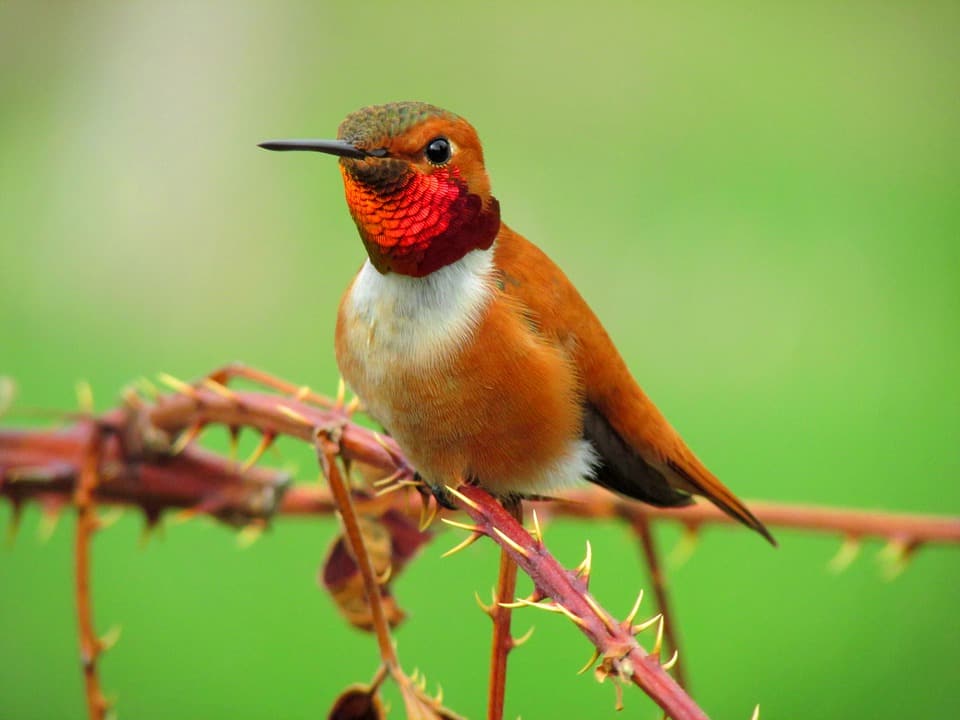
A Diverse Landscape
A diverse landscape also provides perching sites for hummingbirds to rest and hide from predators. Did you know that hummingbirds spend up to 80% of their time perched in trees, shrubs or on plant stems?
These layers also provide potential nesting places. Hummingbirds make tiny cup-like nests made of various plant materials. The nests are frequently camouflaged by lichen and moss. The female hummingbird usually lays two eggs that are the size of small beans. It is very rare to find a nest.
Attract Hummingbirds with Nectar-Producing Native Plants
There are a variety of nectar-producing plants that you can add to your garden to attract and support hummingbirds. When choosing plants for your garden, patio or balcony, select those that are native to your area and well-suited for your growing site.
If your planting area receives full sun, be sure to choose plants that enjoy that much light. If you are planting in shady areas, be sure to choose shade-loving plants. This same philosophy can be applied when it comes to plants that like dry or moist soil conditions.
Hummingbird Plant List
Here a list of plant materials that provide nectar for hummingbirds. Check your local Cooperative Extension Agency, Native Plant Society or the National Wildlife Federation at www.nwf.org, to find suitable nectar plants for your specific area.
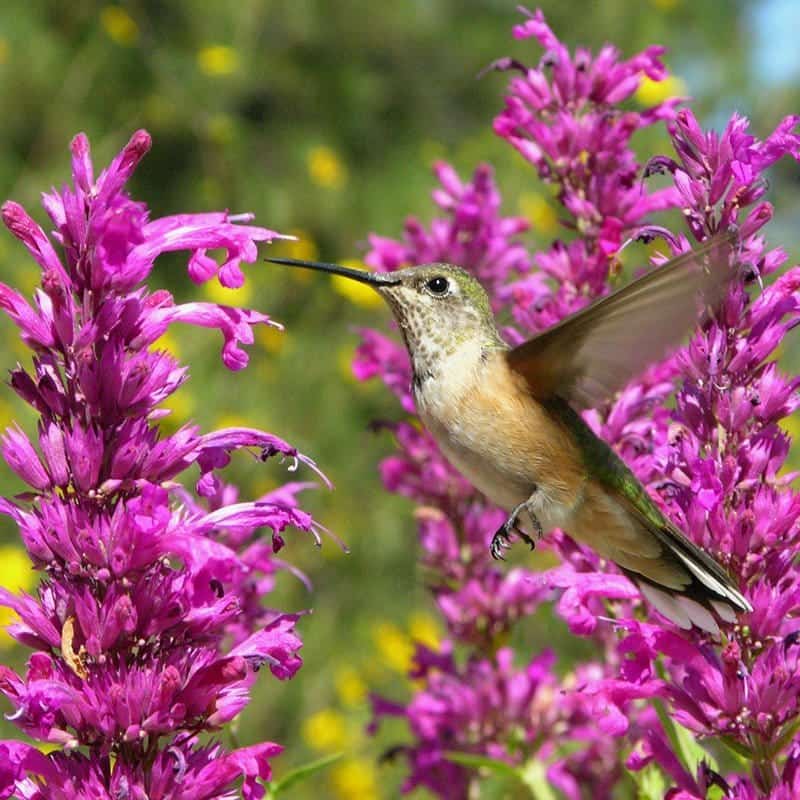
Trees and Shrubs
Bottlebrush Buckeye, Aesculus parviflora
Buttonbush, Cephalanthus occidentalis
Horse chestnut, Aesculus hippocastanum
Red Buckeye, Aesculus Pavia
Rose Mallow, Hibiscus moscheutos
Tulip Tree, Liriodendron tulipifera

Vines
Crossvine, Bignonia capreolata
Trumpet Vine, Campsis radicans
Trumpet Honeysuckle, Lonicera sempervirens
Black-eyed Susan vine (annual)
Cardinal vine
Scarlet Runner Bean vine
Perennials
Anise Hyssop, Agastache spp
Bee Balm, Mondarda spp Canna hybrids
Cardinal Flower, Lobelia cardinalis
Catmint, Nepeta x faassenii
Columbine, Aquilegia spp.& hybrids
Coral Bells, Heuchera spp. & hybrids
Daylily, Hemerocallis spp
Geranium, Pelargonium xhortorum
Great Blue Lobelia, Lobelia siphilitica
Indian Pink, Spigela marilandica
Red Hot Poker, Kniphofia hybrids
Scarlet Sage, Salvia splendens
Check out the flowering perennials at Nature Hills Nursery that attract hummingbirds.
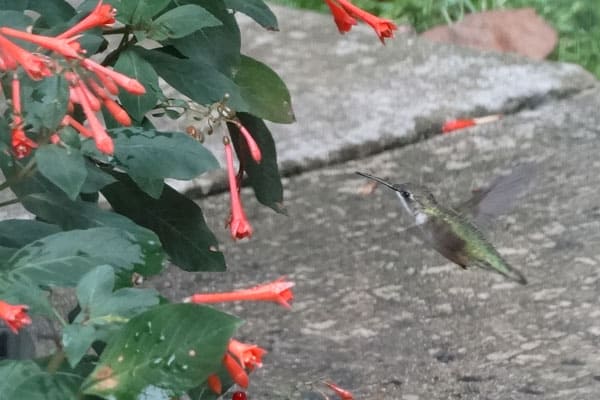
Annual Flowers
Begonia
Four o’clock flowers
Fuchsia
Lantana
Petunia
Sage
Salvia
Attract Hummingbirds with Feeders
Another way to attract these jewels of the garden is to hang special nectar-filled feeders. Place hummingbird feeders where you can enjoy seeing the birds most—near a patio or balcony. Be sure to place the feeder either less than five feet or more than 15 feet away from windows to minimize the risk of a fatal collision.
Nectar feeders are a great way to supplement the flowers in your yard. These nectar feeders also keep hummingbirds in one place for a little while so that you can get a good look at the little winged jewels that visit. Have your camera or iPhone ready to snap a photo, too.
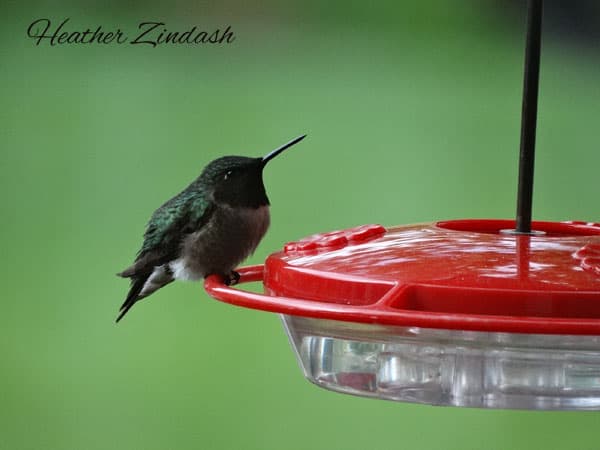
When choosing a hummingbird feeder, select one that can be easily cleaned. Some are even dishwasher safe. Click here for an assortment of different types of hummingbird feeders.
You can easily feed hummingbirds with homemade “nectar.” Homemade hummingbird food can be created by mixing one part white sugar to four parts water. Heat the water to help dissolve the sugar. Be sure the nectar has cooled before adding to the feeder. The extra nectar can be refrigerated for up to one week.
If you don’t want to make your own hummingbird food, you can purchase hummingbird nectar concentrate in liquid or powdered form. All you do is add water. Check out hummingbird nectar on Amazon.
More on Hummingbird Feeders
Hummingbird feeders should be monitored and filled frequently. It is not necessary to boil the water, because the fungus that can grow in the nectar is carried on the bill of the feeding birds. This is one reason why it is important to refill the feeders frequently.
Feeders should be washed thoroughly every three days, and more frequently in high temperatures. When hand-washing feeders, rinse with hot water and add a bit of vinegar to discourage mold growth. Use a small bottle brush to get into small areas and openings. Rinse and dry thoroughly, before refilling the feeder. Do not use honey, artificial sweeteners, brown sugar, or dyes, as they could be harmful to the health of hummingbirds.
Provide Water for Hummingbirds
Water is a vital resource for all living creatures. Because of their diminutive size, hummingbirds prefer water that is only ¼” deep. This can be provided in a shallow birdbath. Rocks can also be added to the bottom to achieve this depth and for better footing.
A mister or sprinkler attached to a garden hose or a small water feature will attract hummingbirds to your yard. Watch in delight as they dart back-and-forth through the light stream of water. They will also drink dew collected on plant surfaces. I once observed a ruby-throated hummingbird light on a wide leaf plant and bathe in the water left by a passing rainstorm.
A Small Container Water Garden is an easy DIY project that you and your hummingbirds will enjoy!
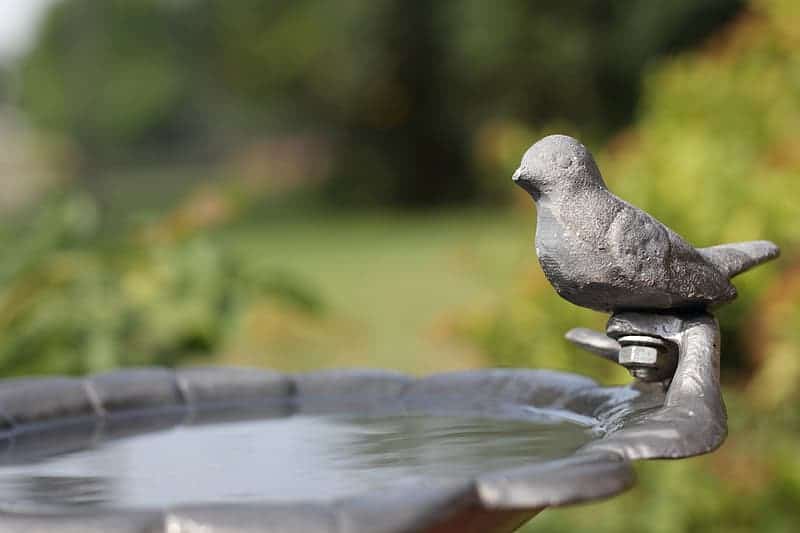
Birdwatching is Good for Your Health!
Birdwatching and spending time outdoors can trigger the parasympathetic nervous system, allowing you to relax, unwind, and unplug. Even a small backyard or balcony can be attractive to hummingbirds and can allow you a respite in nature.
Just add a potted shrub, a flowering vine, some blooming perennials and annuals, and a small water feature to create your own hummingbird habitat. Be sure to water and fertilize your potted plants regularly.
I hope you have been inspired to attract hummingbirds to your garden space, whatever its size and location. You will be rewarded with their flashy jeweled tones as they conduct aerial acrobatics to catch an insect meal, hover over a flower as they sip nectar, or while a male is courting his mate with pendulous swings and a flashing red throat.
6 Quick Tips: How to Attract Hummingbirds to Your Yard
1. Choose plants that are native to your area with long, tubular blossoms in bright red, pink or orange colors.
2. Provide nectar throughout the entire growing season by planting a variety of trees, shrubs, vines, perennials, and annuals that bloom from early Spring through late Fall.
3. Add a hummingbird feeder filled with nectar to supplement your garden and to bring hummingbirds close, so you can enjoy watching them.
4. Add a water feature such as shallow bird bath, a mister or a sprinkler.
5. Strive to provide five layers of vegetation: trees, shrubs, perennials, annuals and ground cover to provide a healthy ecosystem that includes insects, shelter and places to raise young.
6. Avoid using broad-spectrum insecticides on your property that might also kill non-targeted and beneficial insects.
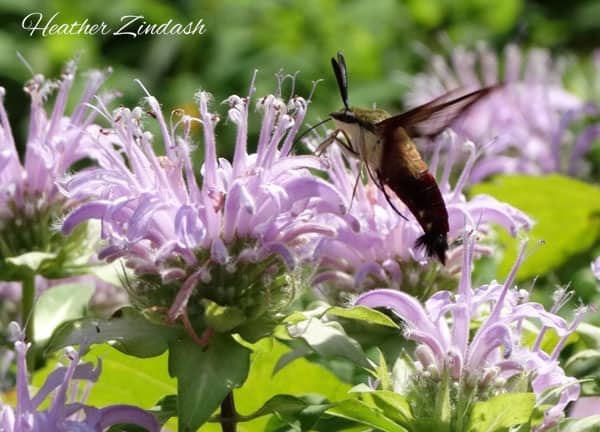
Home Garden and Homestead is part of the Amazon Associates program. When you click on one of our links to Amazon, we receive a commission for qualifying sales. Thanks for supporting this website!



Thank you. Hopefully this first year works. Been feeding birds for decades!
I love hummingbirds but my cats would try to catch them. I love my cats! What can I do?
Very good informative site
Wanda–
Try hanging hummingbird feeders up in your trees where the cats can’t reach them. Also, consider hanging a feeder on a “shepherd’s hook” high above the ground.